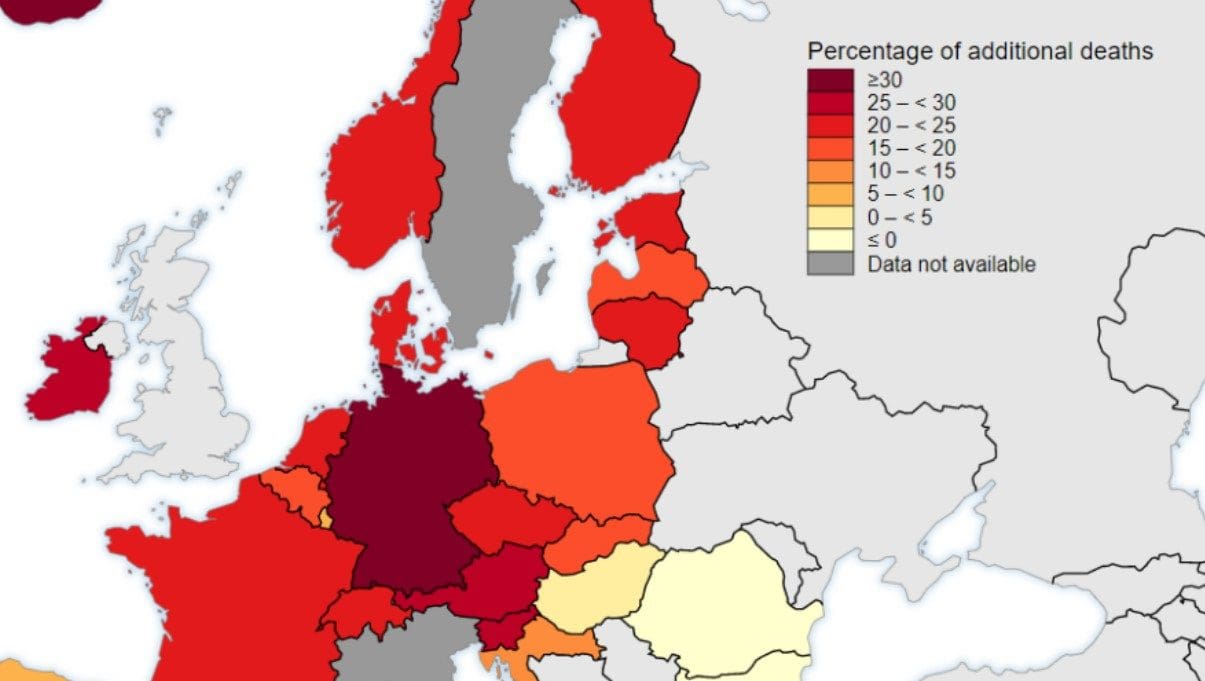Eurostat published its latest statistics about excess mortality rates in the EU in December 2022. The COVID pandemic was already easing its pressure on the population at the time, however, in Germany, excess mortality still rose by 37 per cent. Meanwhile, the same data only showed a 2.8 per cent increase in Hungary.
Overall, excess mortality numbers rose by 19 per cent on average in December in the EU, compared to the median value taken from 2016 to 2019. This is also a sharp increase compared to November, when the rate rose by ‘only’ eight per cent.
In December, the highest registered numbers came from Germany, where the surge reached a staggering 37 per cent. However, significant growth was also reported in Austria (27 per cent), Slovenia (26 per cent), Ireland, and France (both 25 per cent). Compared to the previous average, there was an over 20 per cent increase in deaths in Czechia, the Netherlands, and Estonia (23 per cent); as well as in Denmark (22 per cent), Finland, and Lithuania (both 21 per cent).
While Western Europe showed skyrocketing numbers in excess mortality, Hungary’s numbers only rose by 2.8 per cent.
The Hungarian daily Mandiner asked an expert about the issue. Zoltán Kiss, a researcher at the University of Pécs Medical School told the paper:
‘We should keep in mind the fact that the same numbers recorded during the pandemic rose significantly in the Middle and Eastern European region. And while our country is part of this sample, our numbers managed to stay somewhat lower than in our neighbouring countries. However, compared to Western Europe, they were still higher.’
He also pointed out that in Nordic countries, interestingly, the excess mortality rate was lower during the pandemic than the year before. This means that these nations were able to save more lives during the time of the global health crisis, managing to do so because of their strict regulations and advanced healthcare. He added that in the same period, because of the mask mandates, fatalities connected to other sicknesses such as influenza were much lower than usual—especially among older people with chronic illnesses. He went on to say that, because many avoided the usual winter sicknesses, their immune systems were less strained, making people more resilient.
Dr Kiss added that, according to the data, Western Europeans who are older and more vulnerable were successfully protected during the COVID lockdowns. However, they are starting to catch the diseases that usually come with the winter as pandemic safety regulations are being lifted everywhere.
Many of these elderly people sadly passed away during the COVID pandemic in Hungary, which is why our numbers remain lower, he added.
He also emphasised that the part of the data that refers to Czechia and Poland is noteworthy since the excess mortality is a lot higher there than in Hungary. However, please note that their mortality rates were above ours by much during the time of the pandemic as well. The expert quoted by Mandiner explained that at the same time, it is also possible that the upper respiratory tract epidemic has reached or is reaching these countries in different cycles, which may provide a further explanation for these significant differences.
So this time, it is Western Europe that is ‘catching up’ with Eastern and Central Europe in this sad regard. As Zoltán Kiss puts it:
‘In the long run, over the years, the increase in excess mortality that has been passed on will be nullified, since older patients with chronic illnesses and high mortality risks cannot be kept alive forever. One lesson from the pandemic is that mortality and excess mortality data should be evaluated over the long term. Consequently, it will remain important to continue monitoring this excess mortality data in the coming months and years.’








